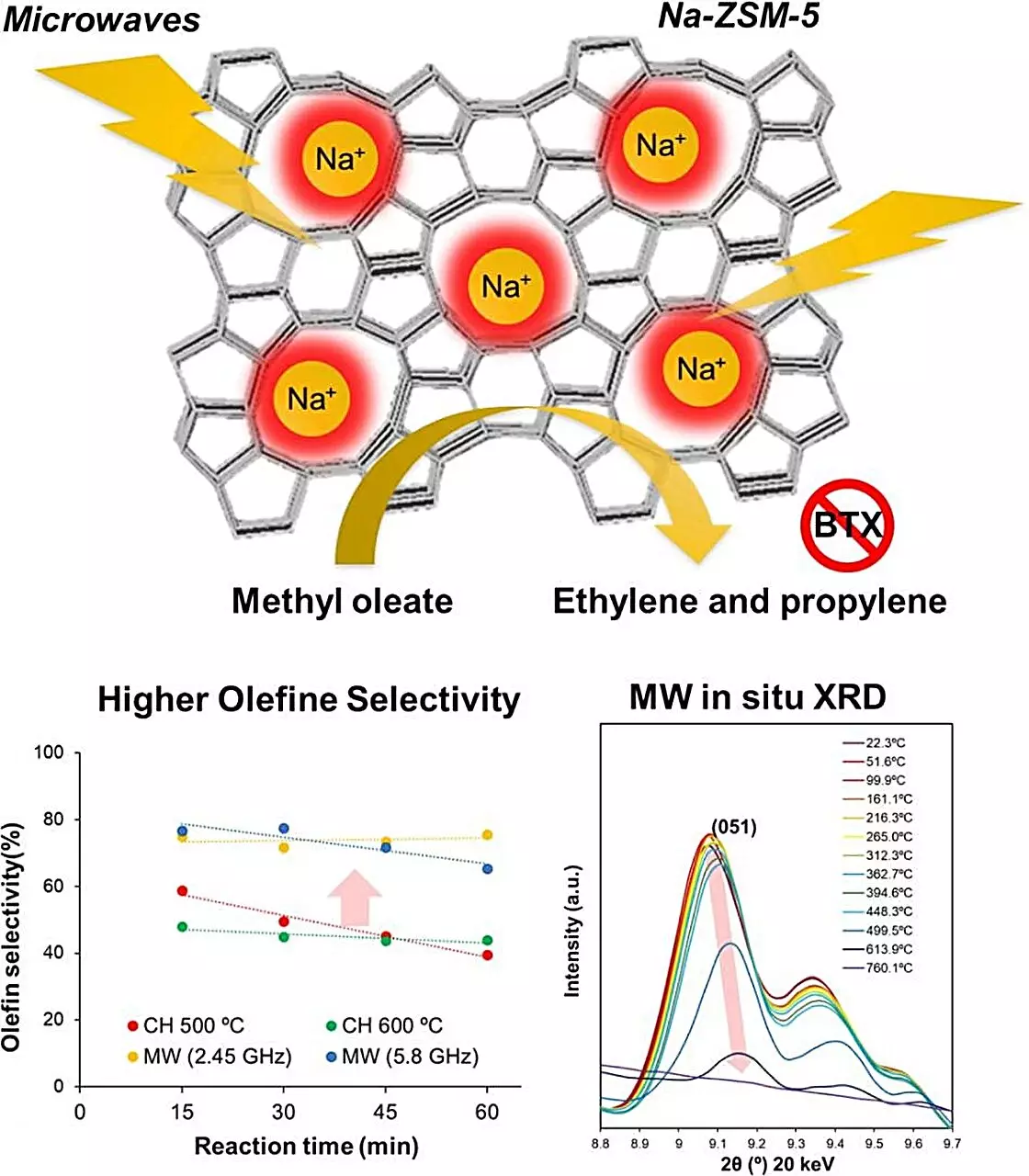The quest for sustainable chemical manufacturing has spurred a variety of innovative approaches to convert biomass into essential precursors for plastics, pharmaceuticals, and other organic compounds. Researchers from Kyushu University have made significant strides in this field, focusing on enhanced catalytic processes that can facilitate the efficient conversion of abundant and often waste materials into valuable chemicals. Their groundbreaking study, published in the Chemical Engineering Journal, introduces Na-ZSM-5, a zeolite material, as a promising catalyst when subjected to microwave heating, thereby proposing a game-changing methodology for the chemical industry.
Conventional methods of converting biomass into olefins often rely on high-temperature processes, such as the reforming of naphtha, which not only consume vast amounts of energy but also release substantial greenhouse gases. Catalytic cracking using zeolite has been a widely accepted alternative; however, this method is also energy-intensive, typically requiring temperatures exceeding 500°C. Such high temperatures can lead to unwanted complications such as coking, where carbon deposits build up and diminish the effectiveness of the catalyst. The environmental ramifications of energy consumption and carbon emissions associated with these processes have led scientists to seek novel approaches that reduce energy demands while maximizing yield.
At the forefront of this research is Na-ZSM-5, a sodium-ion substituted zeolite recognized for its unique structures and properties that promote catalytic reactions. The Kyushu University research team, led by Associate Professor Shuntaro Tsubaki, systematically evaluated various zeolite materials to ascertain their effectiveness in microwave-based catalytic processes. The result was a targeted focus on Na-ZSM-5, which displayed superior microwave absorbance and catalytic efficiency compared to its counterparts.
The fundamental mechanics of using microwaves as an energy source mark a significant departure from traditional heating methods. The microwaves can penetrate the catalyst directly, promoting energy efficiency and minimizing wasted thermal energy. This selective thermal application enables the generation of localized hot spots within the zeolite structure, allowing the material to reach and maintain required reaction temperatures while avoiding the detrimental effects typically associated with high-temperature processing.
The researchers conducted extensive experiments, notably demonstrating the catalytic conversion of methyl oleate into valuable olefins using microwave heating. Their findings were compelling: Na-ZSM-5 exhibited conversion efficiencies significantly higher than traditional heating methods, achieving remarkable selectivity while suppressing unwanted byproducts such as carbon dioxide and carbon monoxide. Notably, when microwave heating was applied, the production of olefins increased fourfold compared to conventional heating methods — a striking advancement in olefin synthesis.
The elimination of coking during microwave treatment, even at elevated temperatures up to 600°C, presents a substantial advantage. This not only extends the lifespan of the catalyst but also contributes to the overall sustainability of the process. The incorporation of microwaves in catalytic reactions aligns with the industry’s growing trend toward reducing energy footprints and enhancing chemical production’s environmental viability.
An intriguing aspect of the Kyushu University researchers’ study was their focus on the changes that Na-ZSM-5 undergoes when exposed to microwave radiation. Their analysis revealed that the localized temperatures within the zeolite’s crystal lattice could surpass 1000°C, despite the bulk material maintaining a more stable 500°C. This phenomenon is crucial, as it enhances the catalytic properties of Na-ZSM-5, enabling a more targeted reaction pathway toward olefin production.
Such insights not only deepen the understanding of zeolite behavior under microwave conditions but could also inform future applications and improvements in catalytic systems. The ability to control reaction conditions at a microscopic level opens avenues for optimizing performance across various chemical processes.
With the pressing need for environmentally conscious production methods, the findings from Kyushu University may herald a new era in the chemical industry. The prospect of generating microwaves from renewable energy sources such as wind and solar further enhances the sustainability narrative, allowing for more planet-friendly chemical synthesis processes. The researchers aim to refine microwave-driven catalytic processes, enhancing both yield and energy efficiency, potentially scaling this technology for real-world applications.
As global industries move toward electrification and sustainability, microwave-assisted biomass conversion could emerge as a leading solution for meeting the chemical needs of the future while reducing environmental impacts. The research team at Kyushu University is poised to play a crucial role in this transformation, paving the way for a greener and more efficient chemical manufacturing industry.

